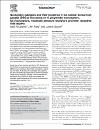Nociceptor subtypes and their incidence in rat lumbar dorsal root ganglia (DRGs): focussing on C-polymodal nociceptors, A?-nociceptors, moderate pressure receptors and their receptive field depths
الملخص
A recent study with Ca++-sensitive-dyes in neurons in whole DRGs (Table 5) found that much lower percentages of nociceptors were polymodal-nociceptors (PMNs) (Emery et al., 2016), than the 50–80% values in many electrophysiological fiber studies.
This conflict highlighted the lack of knowledge about percentages of nociceptor-subtypes in the DRG. This was analysed from intracellularly-recorded neurons in rat lumbar DRGs stimulated from outside the skin. Polymodal nociceptors (PMNs) were 11% of all neurons and 19% of all nociceptors. Most PMNs had C-fibers (CPMNs). Percentages of C-nociceptors that were CPMNs varied with receptive field (RF) depths, whether superficial (∼80%), dermal (25%), deep (0%) or cutaneous (superficial + dermal) (40%). This explains CPMN percentages 40–90%, being highest, in electrophysiological studies using cutaneous nerves, and lowest in studies that also include deep RFs, including ours, and the recent Ca++-imaging studies in whole DRGs.
Despite having been originally described in 1967 (Burgess and Perl), both Aβ-nociceptors and Aβ-moderate pressure receptors (MPRs) remain overlooked. Most A-fiber nociceptors in rodents have Aβ-fibers. Of rat lumbar Aβ-nociceptors with superficial RFs, 50% were MPRs with variable medium-low trkA-expression. Despite having conduction velocities at the two extremes for nociceptors, both CPMNs and MPRs have relatively low thresholds, superficial/epidermal RFs and low trkA-expression. For abbreviations used see Table 5.
المجموعات
- أبحاث الطب [1711 items ]



